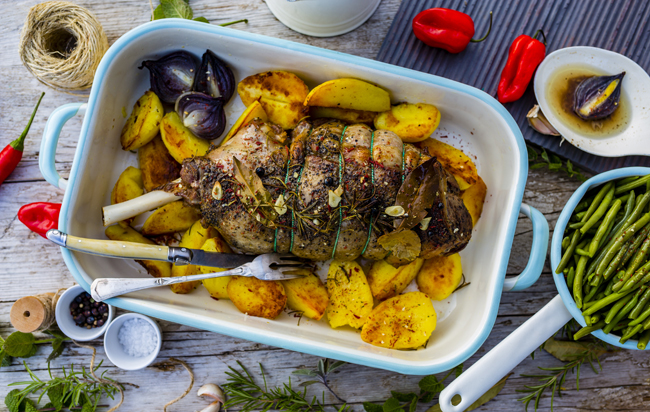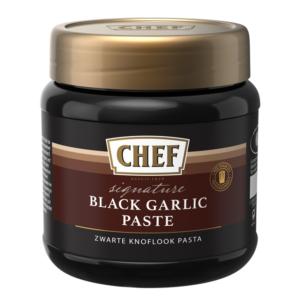Roasting revolution: The latest trends in roast meats
With new cuts for roasting and consumers increasingly willing to stray out of their comfort zones, food operators should not be cowed by meat-free Mondays, writes Richard McComb
The Sunday roast remains one of the quintessential British meals, imbued with tradition, feel-good emotions and, crucially, bags of flavour. In polls of Britain's favourite dishes, it is a serial winner, seeing off challenges from apple crumble, hearty pies, cream teas and chicken tikka masala.
But in a crowded marketplace, and in the face of changing dietary habits, caterers across the board, from restaurants to food- service, are under pressure to clarify their offer when it comes to roast meats. Vegetarianism and plant-based eating represent a commercial threat to operators who earn a crust from carnivores. Quality products will always stand out for diners, but complacency, as in any business, is perhaps the greatest enemy. Chefs rest on their laurels, or their rib roasts, at their peril.
Official figures suggest beef consumption in the UK has remained "fairly stable" in recent years, at around 100g per person per week, according to the latest Family Food report, published annually by the Department for Environment, Food & Rural Affairs. Sales of chicken have risen over the past decade and it is now the most popular unprocessed meat product (193g per person per week). Pork is also "relatively stable", but lamb has shown a downward trend.
Despite this apparent resilience, campaigns such as Veganuary and Meat-Free Monday are having an impact. An August 2017 report by Mintel found that 28% of meat-eaters had reduced their meat consumption in the previous six months. Health was the main reason, followed by weight loss, animal welfare and the environment.
More bang for your buck
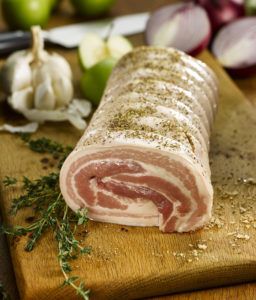
n it comes to roasts, variety may be the spice of life. Rob Owen, executive development chef at Creed Foodservice, advises chefs to look beyond sirloins, fillets, topside and silverside roasting joints to consider value-for-money forequarter cuts, shin or leg/shank, and chuck and brisket for slow roasting.
"Slow-roasted joints appeal to consumers' sense of nostalgia and help the meat budget go further," Owen says. "We are seeing an increase in the popularity of pork and particularly belly pork, previously overlooked because of its high fat to meat ratio. But it's a tender, tasty cut and ideal for slow roasting. Pork shoulder or leg too are cheaper than other joints of meat and they give a deliciously moist roast."
Chefs are in broad agreement that cheaper roasting cuts offer heightened interest as well as great value for customers.
Steven Ellis, chef proprietor at the Oxford Blue, Old Windsor, reports strong demand for dishes such as pig's trotter. "At first, guests tend to be quite intimidated by the thought of eating a pig's foot, but as the dish is a more refined and modern take on the classic, once they try it, they are pleasantly surprised and will order again. Kitchens don't always need to use prime cuts. With a little creativity, people are willing to sample something more unusual."
Luke Hawkins, head chef at Bristol's Kensington Arms, says venison is gaining popularity, with the haunch roasted either on or off the bone. For alternative cuts, he champions rump caps for flavour and tenderness.
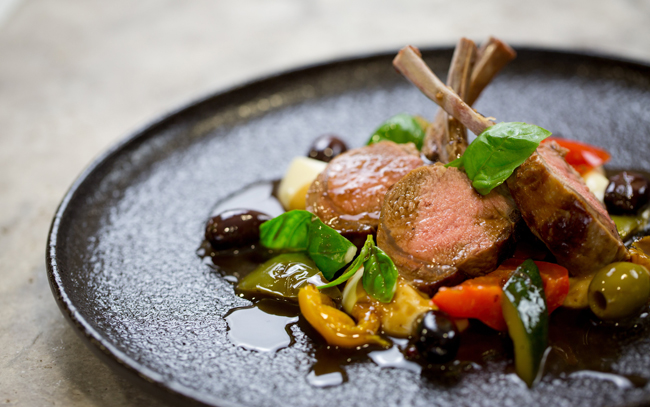
kins urges chefs to seek out lamb that has been dry-aged for 50 days to get the best flavour, especially from the neck. "A thrifty option would be to use a smaller prime cut of meat and pair it with a slow-cooked ox cheek," he adds.
Dave Mothersill, group head chef at the Coal Shed and the Salt Room in Brighton, says cheaper cuts such as short rib and beef cheek may require longer cooking times and more kitchen prep, such as trimming, marinating and browning, but the end result is an "amazingly tender piece of meat, full of flavour".
The meat of the matter
"Just because a meat is 'local', or has a farm name attached to it, does not guarantee its quality," he warns. "Meat that carries national accreditations supplied by a butcher you trust is essential. The Red Tractor standard ensures full traceability back to the UK farm where the animal was reared, as well as adherence to rigorous food safety guidelines. RSPCA Assured products are also UK-traceable and ensure animals have received high standards of care."
Emmet Doyle, meat trade marketing specialist for Bord Bia, the Irish Food Board, echoes the need for operators to understand the "granular detail" of the farm-to-fork journey. Was the beef raised sustainably? Were the cattle fed a grass-based diet, the primary food of British and Irish beef? Does the product come from farm assurance schemes, such as Ireland's sustainable beef and lamb assurance scheme (SBLAS)?
Doyle says: "Serving quality meat is absolutely a footfall driver, but a vital trick missed by many operators is educating their team members about the produce and its narrative. It's all well and good the chef knowing the meat inside out, but the front of house staff have to be equally knowledgeable and passionate about the meat they are serving."
A taste of Spain
Spanish food supplier Mevalco is seeking to demonstrate the quality of "old cow", using animals over eight years old. As David Menendez, Mevalco founder and sales director, explains: "The marbled meat is exquisite and has a great depth, complexity and length. The marbled meat has been likened to wagyu, against which it represents incredible value."
Selected heritage Spanish breeds include AvileÁ±a, Asturiana de la MontaÁ±a and Rubia Gallega, and there is growing demand for "txuleton", a thick rib steak popular in the Basque Country.
Mevalco's prime cuts are dry-aged for at least two weeks and can be aged for longer for deeper flavours. "This type of bespoke service is becoming increasingly important for chefs in order to deliver their signature dishes and create new and inspirational menus," says Menendez, who reports strong interest for Pyrenean lamb and Ibérico pork from the Aragon region, where the range includes cheeks, abanico (bavette), tenderloin and pluma (feather).
James Robinson, product trainer at Brindisa, explains the range of options offered by Spanish pork, including the finest Ibérico de bellota (acorn-fed) and Ibérico cebo de campo (pigs fed on acorns and grain), which offers value for money without compromising taste.
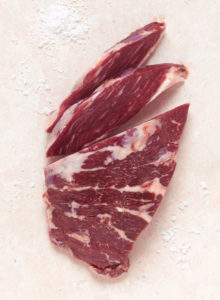
inson says: "Though very different from that of the European white pig, Ibérico cebo de campo pork is succulent and notably rich in health-promoting mono and polyunsaturated fatty acids, iron, zinc and vitamins B and E. The best cuts for roasting include ribs, loin, and smaller cheeks, but the shoulder - or presa - stands out because of its fat marbling, which when seared before being slowly roasted breaks down to become exquisitely gelatinous.
"The presa cut is not usually separated in UK butchering and is rapidly developing a loyal following. It is thick with a light marbling, which - unusually for pork - should be cooked medium rare. The result is a tender, flavoursome meat."
Lean and mean
With so many options on the meat market, some commentators suggest it may be time to give beef the bird. Steve Lyons, sales director at Thomas Ridley Foodservice, points to a surge in popularity for ostrich meat. Try ostrich steaks with roasted vine tomatoes, sweet potato fries and classic béarnaise sauce. "It's a very lean meat and is rich in iron, low in cholesterol and a great way to get a tasty meat that is low in fat," he says. However, the lack of fat means that chefs must be careful not to overcook it - it needs a high heat to sear the meat and then ensure it's still a little pink inside. It can even be eaten rare."

ther example is pheasant: good value and perfect for health-conscious diners seeking lean meat options, and Charlotte Ponti, savoury food manager at Nestlé Professional, highlights the growing consumer appetite for poultry (chicken, turkey, quail and guinea fowl), which is seen as a healthier alternative to red meat.
Nestlé Professional's roast seasoning liquid will boost the flavour of the now popular veal cut - ossobuco - while its black garlic paste gives a sweet and umami-rich flavour to stews.
Brakes is offering joints of meat that chefs can enjoy while getting back to basics. Colin Scott, Brakes' business development chef, explains: "These products allow them to challenge their repertoire and use their skills to boost food knowledge through a more hands-on approach. This approach can result in secondary cuts of meat that not only offer amazing flavour but also cost benefits. Good examples of this would include slow pot-roasted Angus brisket or feather blade, suckling pork belly enveloped, stuffed and tied, cured bacon joints, roasted whole rump of beef, and boned and rolled turkey legs."
Stuart Nicholson, head of product development at Oliver James, says chefs should also seek out the "eye of chuck" to cook whole sous vide, picanha roasts from the rump cap and slow-cooked pork collar.
And whatever you do, don't forget the trump card for any roast: meaty, moreish gravy.
An Essential Cuisine survey found that 70% of customers would be put off from returning to a place that served substandard gravy. Business development chef Jonathan Harvey-Barnes says: "Good gravy is everything, yet so often its importance is overlooked. Remember, even the finest, most expensive cut of meat can be spoiled by a bland, unadventurous gravy."
Essential Cuisine's No1 gravies contain meat stock, fat (chicken flavour) and dripping (beef flavour). The company also provides a vegetarian and vegan-friendly savoury flavour. All are gluten-free and can be enhanced with wine, herbs and meat juices.
Harvey-Barnes adds: "In the heat of kitchen life, it makes sense for brigades to save valuable time by using a bought-in gravy, but it's absolutely essential not to sacrifice quality and consistency for convenience and corner- cutting. Get it wrong and the results are conclusive - your customers will vote with their feet."
Suppliers
Bord Bia
www.irishbeef.co.uk
Brakes
0345 606 9090
www.brake.co.uk
Brindisa
www.brindisa.com
Creed Foodservice
www.creedfoodservice.co.uk
Essential Cuisine
01606 541490
www.essentialcuisine.com
Mevalco
www.mevalco.com
Nestlé Professional
0800 745 845
www.nestleprofessional.co.uk/chef
Oliver James
01527 596606
www.oliverjamesfoods.com
Thomas Ridley Foodservice
01359 270536
www.thomasridley.co.uk



